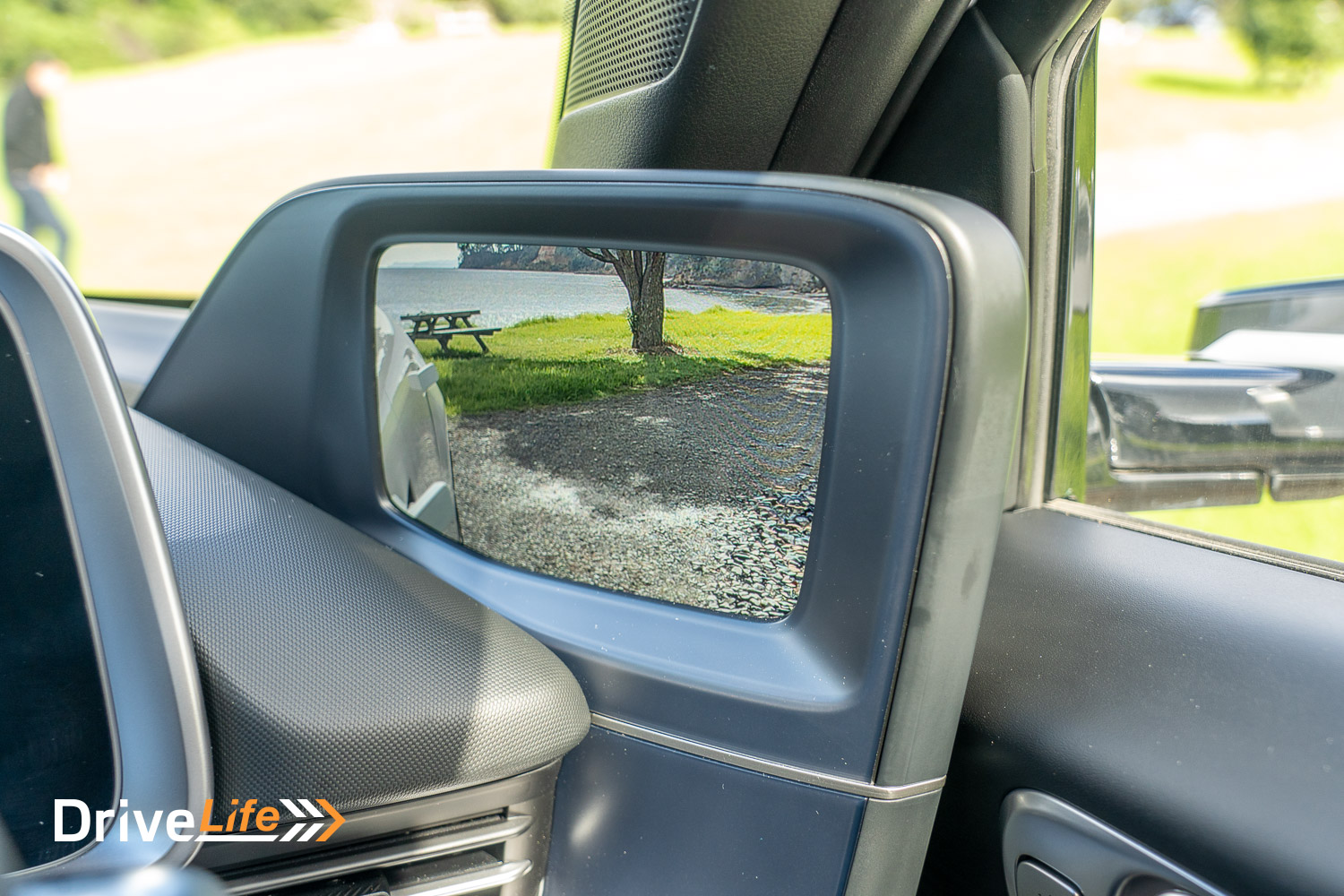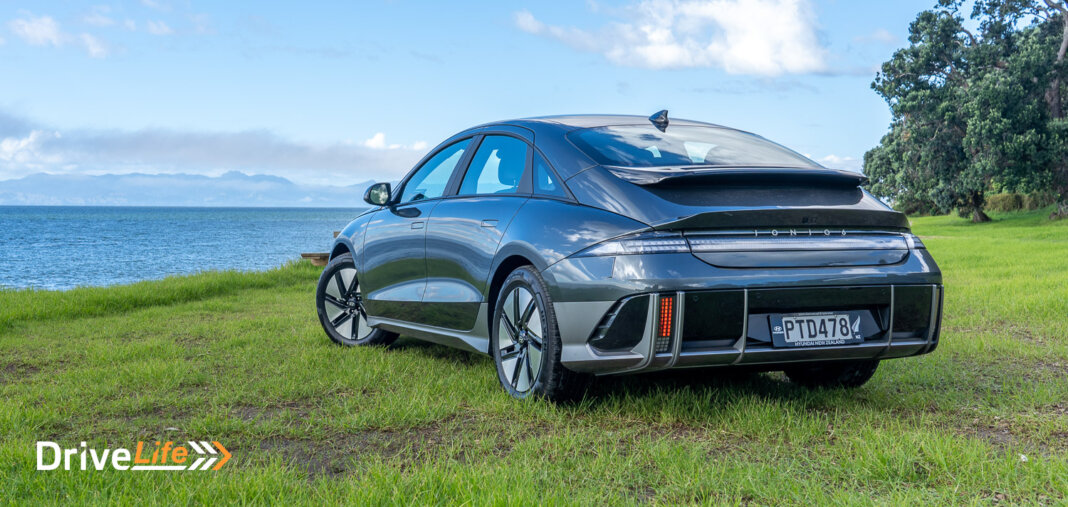Lately, it seems Hyundai can do no wrong. It’s received a number of worldwide awards, not least of which was the New Zealand Car Of The Year award in 2021.
Hyundai New Zealand has always said the Ioniq 6 would come here. The sleek, swoopy design and large interior space – mainly due to it being built on an EV-only chassis – means it’s a car that may do well in the New Zealand market.
However, there is always a ‘but’ – and that is that New Zealanders have a love affair with SUVs. Look at Ford, dumping all their sedans and hatchbacks, and selling only vans, utes and SUVs. Is the writing is on the wall for a 4-door sedan, no matter how it looks? Tesla has done well with their Model 3 but now they have their Model Y SUV, sales of the Model 3 have dropped while buyers move to the Y instead.
Hyundai invited us to the launch of the all-new Ioniq 6, in Auckland.
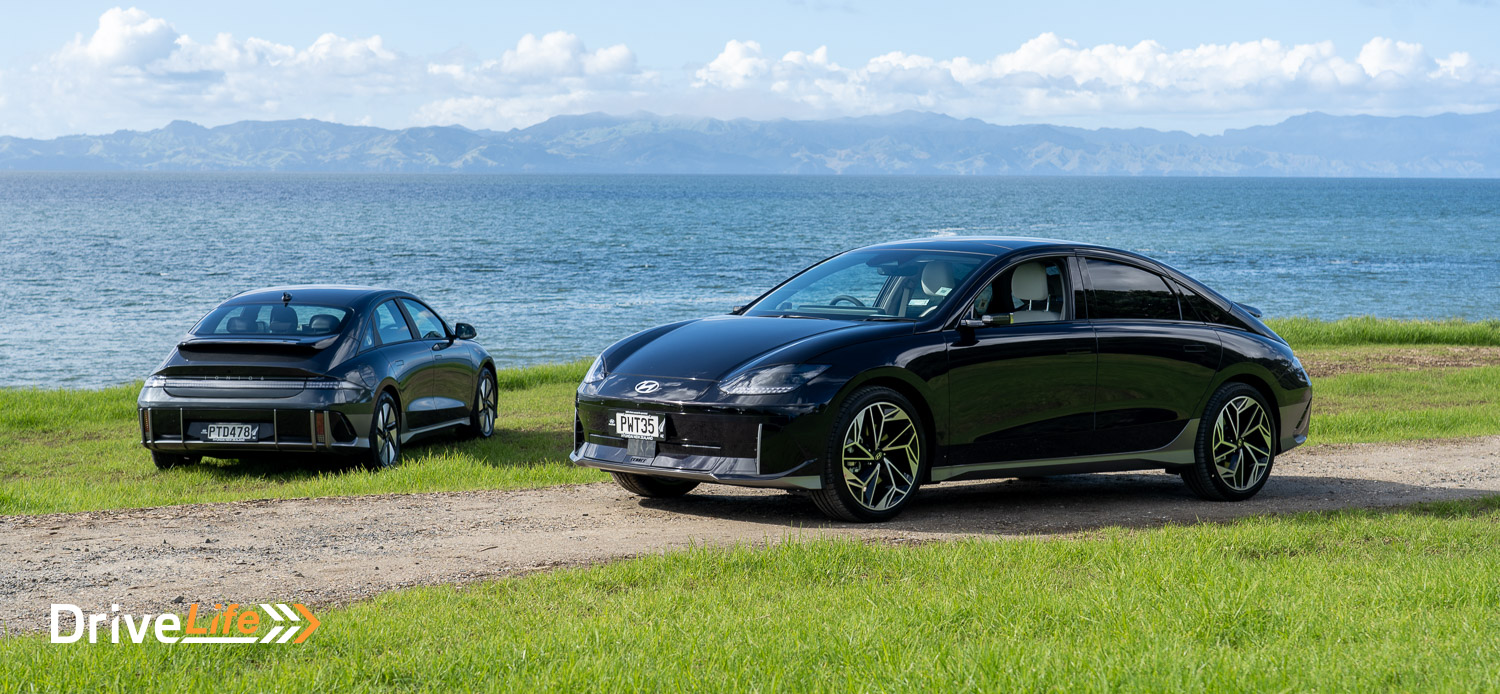
2023 HYUNDAI IONIQ 6 LAUNCH: STATE OF THE EV NATION
Leaving Hyundai New Zealand’s headquarters in Mt Wellington, we hit the road in the new model, which you can read about later. Our first stop would be for lunch and a presentation of things EV in general, and then some details around the Ioniq 6 in New Zealand spec.
In a nice move that’s not been done before, the entire presentation’s audio/visuals were done using a Vehicle-to-Load (V2L) adaptor plugged into an Ioniq 6 sitting right next to us. It was a great start to the info session, running the presentation from the car’s EV battery.
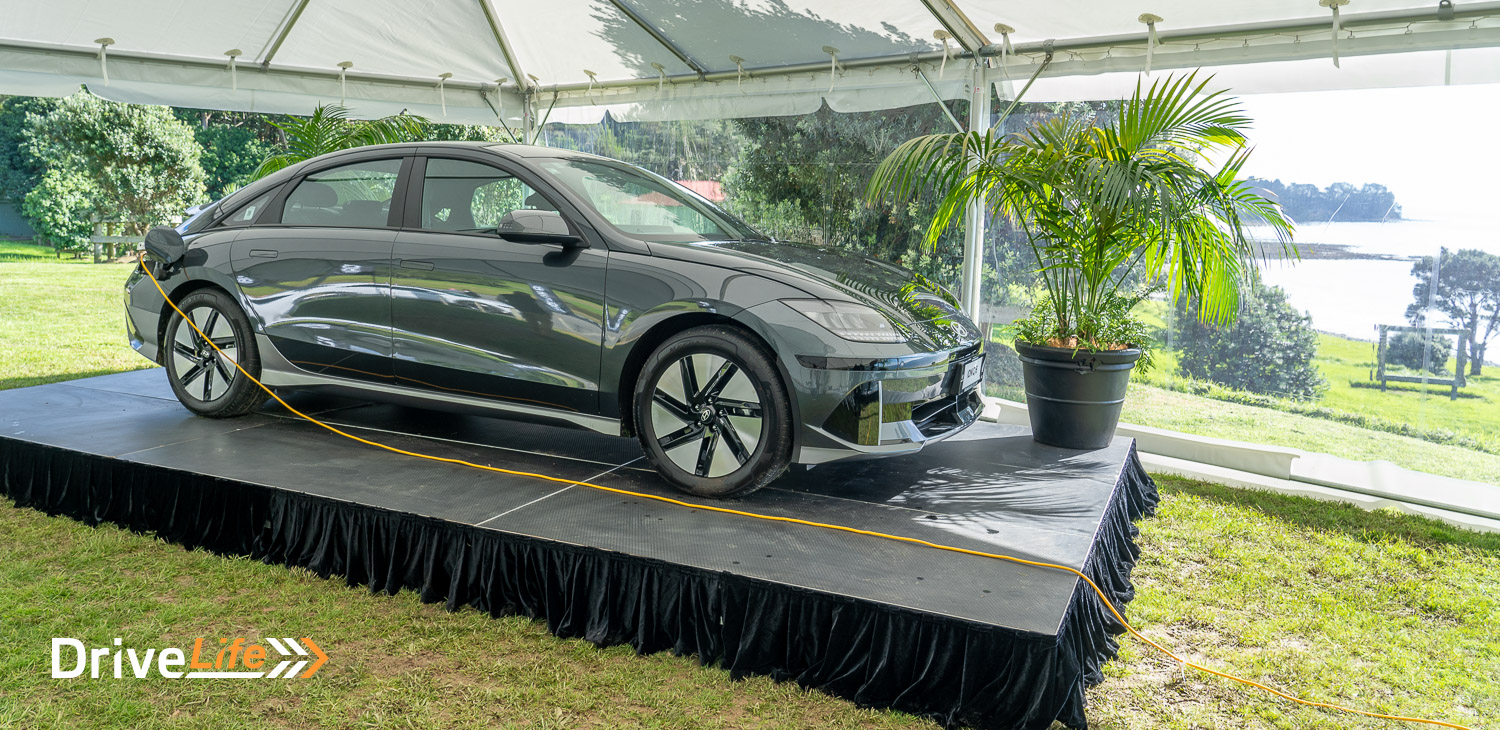
Ioniq, which comes from merging two words together (Ion and Unique) is now a separate brand in its own right, although cars like the Kona EV are not included; Ioniq models will only ever be models that are built in an EV-specific platform, unlike the Kona that has is a shared platform.
The first Ioniq was launched in 2016, with 3 drivetrains available; full EV, Hybrid, and plug-in Hybrid. It’s been a successful model and remains on sale today. In 2016, the Kona EV was launched and then in 2019 the Nexo fuel-cell EV was launched (but not available in New Zealand).
In 2021, the Ioniq 5 was the first model to use the all-new E-GMP platform, a dedicated EV-only platform with features like ultra-fast charging at 350kW, Vehicle-To-Load, and a flat floor.
For 2023, the Ioniq 6 joins the 5 as the latest model.
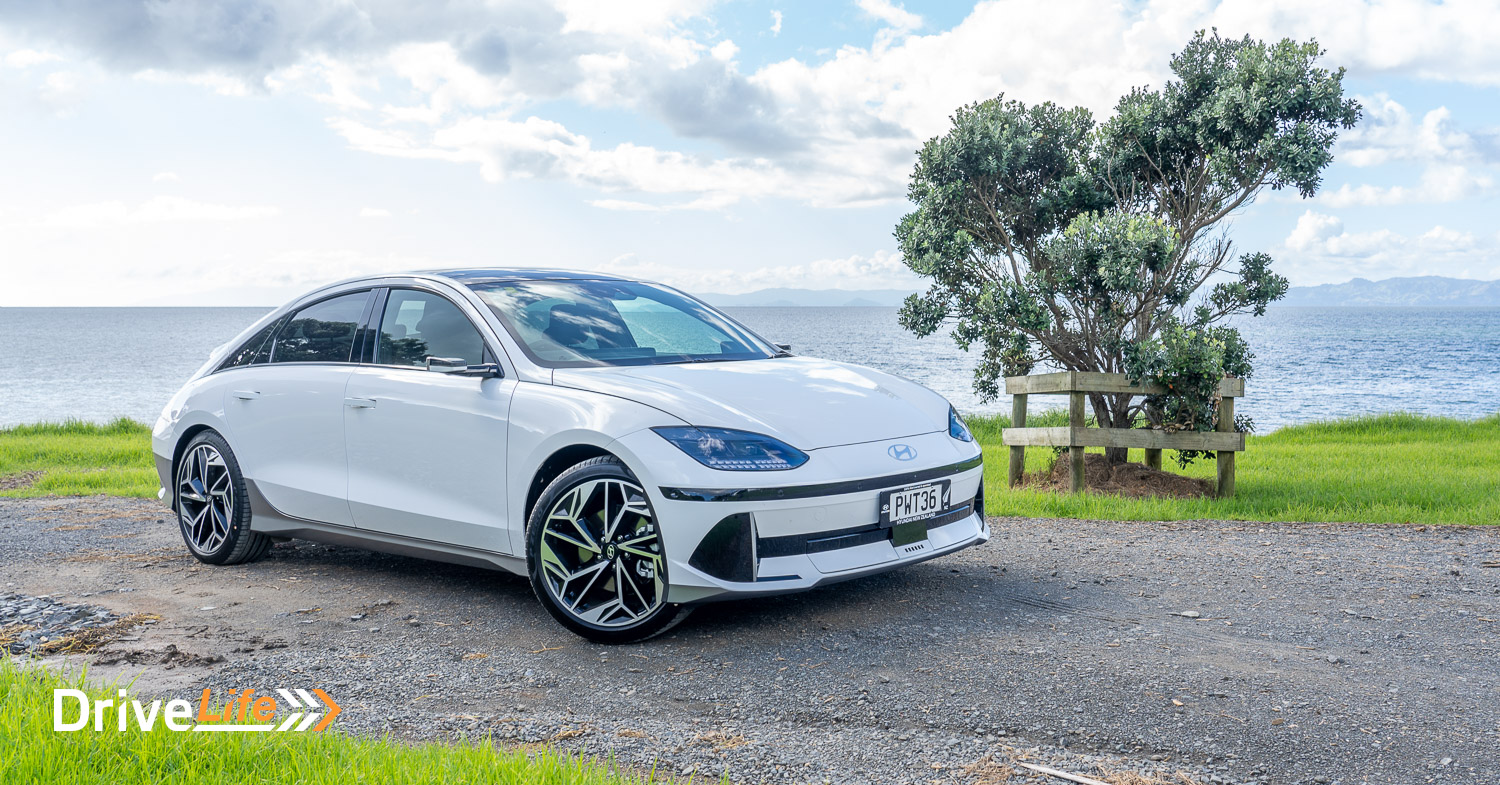
Although the Ioniq 5 N won’t be launched until next year, it will be revealed at the Goodwood Festival in July of this year. This year will also see a new Kona EV, and next year we’ll get the all-new Ioniq 7, a full-size SUV EV.
Ross Wenzlick, Product and Dealer Specialist for Hyundai New Zealand, suggests that the Ioniq 6 will be “taking the vehicle beyond just a means of transportation”. We’ll see about that another day when we fully review the car.
The Ioniq 6 does come to New Zealand with a feather in its cap; while in 2022, the Ioniq 5 won World Car Of the Year, the Ioniq 6 won the same award this year. No pressure, then.
It does arrive in New Zealand at a good time for EVs. In July 2021, when the Clean Car Scheme was launched, EVs benefitted greatly, and Ross claims that, in his view, “in 2023 full EVs will overtake hybrids for sales”.
Currently for Hyundai, 38% of all vehicles sold have some form of hybrid or EV component, with 20% of all sales as full EVs (2019-2022 stats). Compare this to 2020 when 70% of all vehicles sold were straight petrol. In 2022, that’s already down to 40%.
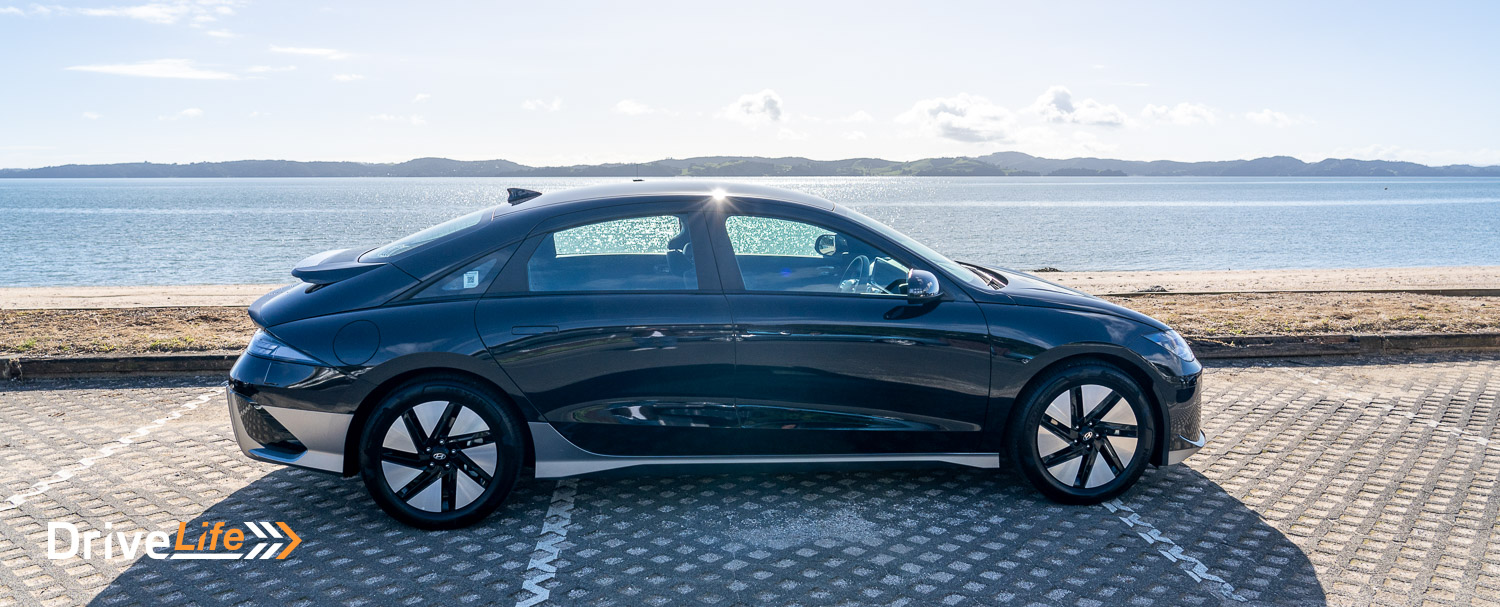
2023 HYUNDAI IONIQ 6
So what’s up with Hyundai launching a 4-door sedan, in a world in love with SUVs? “Yes, New Zealanders are trending towards SUVs,” says Ross, “but we believe there is a market there. There is still a demand for a saloon, and EVs offer a great opportunity for saloons to come back into the market.” DriveLife sure hopes so, there is nothing wrong with a great sedan.
Next up to speak was Gavin Young, Aftersales Manager for Hyundai New Zealand (HNZ). It felt almost cliched when he suggested that the Ioniq 6 is a “significant game changer for Hyundai New Zealand”. Still, it has the credentials and it is a sedan, so we hope so.
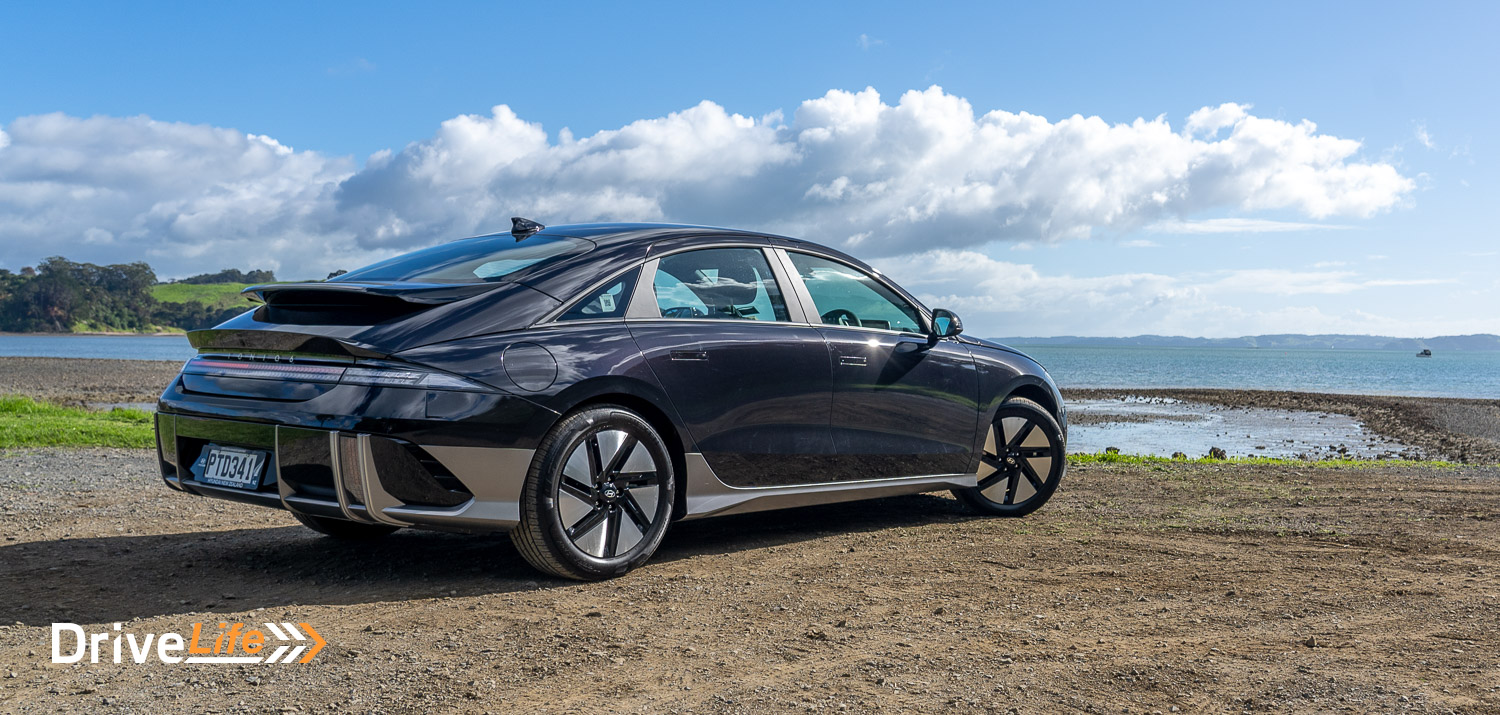
The Ioniq 6 is built on the same E-GMP platform as the Ioniq 5. It’s modular and can be standardised for a model line-up very quickly he suggests. Apparently, it’s also easy to increase the wheelbase for different models using that same platform, and it can also have front or rear traction motors.
For the Ioniq 6, rear-wheel drive is standard, with all-wheel drive reserved for the top-spec Limited model. The battery pack is 400/800 volts, so it can accept a high state of charge using a hypercharger. Using 800 volts means it can accept up to 300kW of charge at an appropriate hypercharger. It can actually take 350kW of charge but we don’t have one of those in New Zealand yet.
As mentioned, like the Ioniq 5, the 6 is capable of V2L, so you can run up to 3.6kW of household appliances off the car. This could be ideal for those who might take their Ioniq 6 camping. It does cost around $1,000 for the V2L adaptor, although the Elite and Limited models have a 230-volt socket in front of the rear seat inside the car, so no need for the adaptor. Keep in mind this socket is limited to 10 amps, just like a normal household power point.
But you can still purchase the V2L adaptor for the Elite and Limited models, and run cords from both that and the power socket under the back seat. The draw on the V2L adaptor can be set so it doesn’t suck too much power from your EV batteries. HNZ says they are selling 10-15 V2L adaptors per month, with most of them being purchased after the car has been purchased.
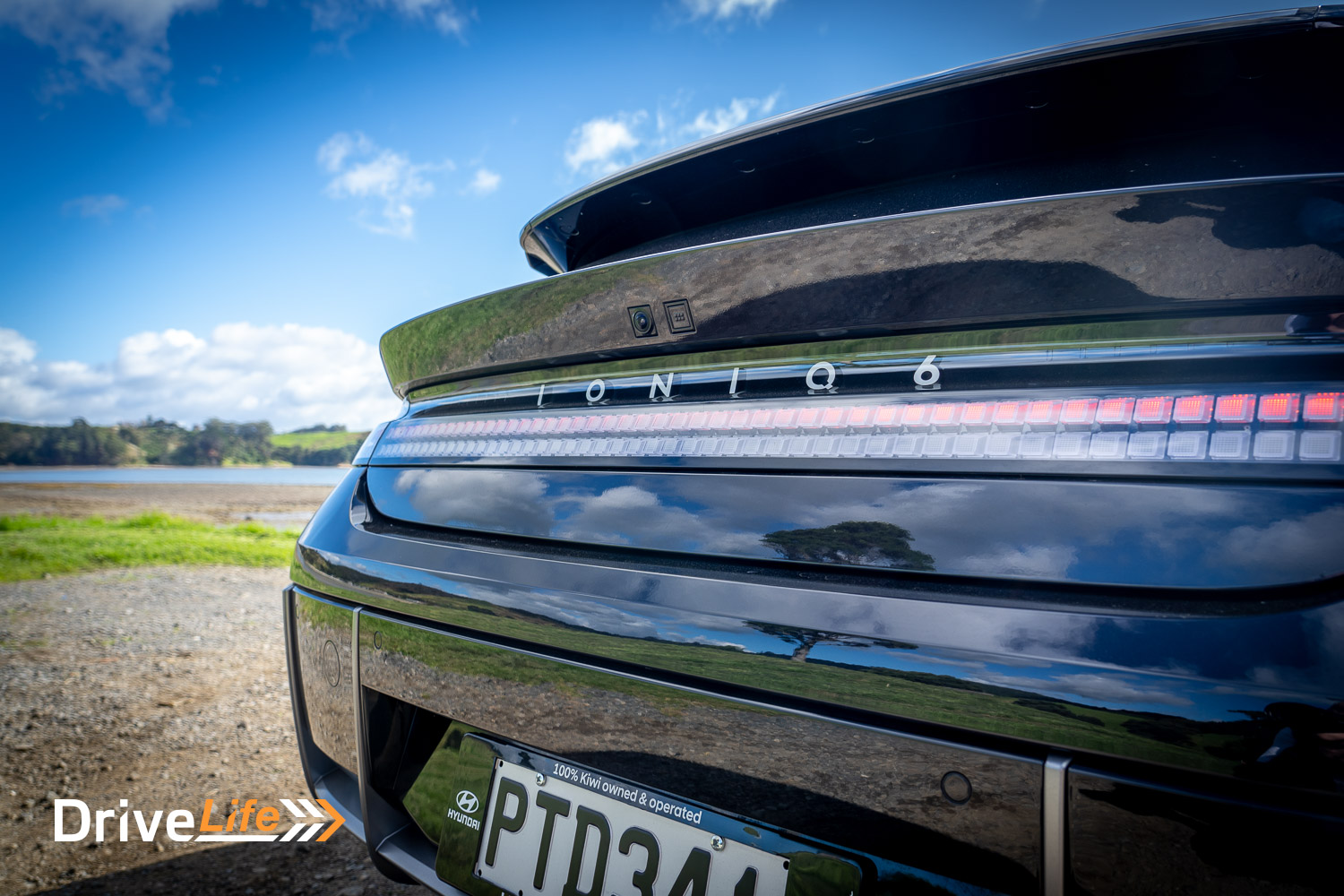
IONIQ 6 Launch: Charging
While the Ioniq 6 comes with a standard household 230-volt charger, Hyundai suggests that this is only used in an emergency, and treated “like a spare tyre”. They strongly encourage any Ioniq buyers to put in a wallbox at their home, to assist in speedier recharging.
On an 11kW wallbox charger at home, charging your Ioniq 6 from 10-80% will take 7 hours – so plug it in overnight and walk away.
If you aren’t at home and have access to a hypercharger, that will get the car from that same 10-80% in 25 minutes, and a ‘normal’ DC fast charger, the most common we have in the country, will take 73 minutes to get from 10-80%. Just enough time for lunch while out and about. All these figures are based on the larger 77.4kWh battery, so the 53kWh battery pack will charge much more quickly.
To assist in reducing energy consumption, the Elite and Limited models both have a heat-pump AC unit, while all models have a battery conditioning system to assist in better fast charging.
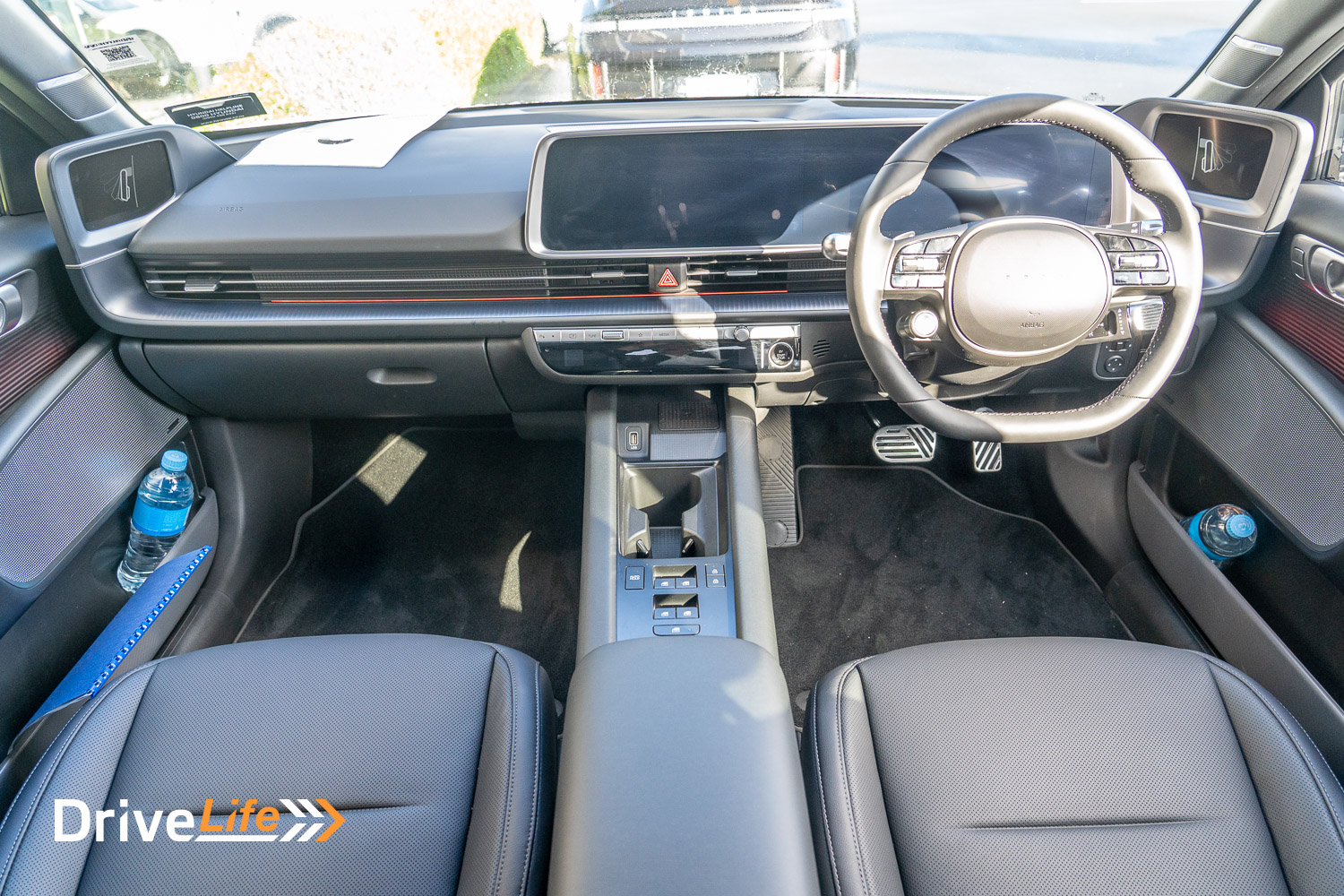
IONIQ 6 Launch: Design
Like the Ioniq 5, the 6 has Parametric Pixel headlights and DRLs at the front, a signature design feature for the Ioniq brand. At the front, there are side air curtains and an active air flap to assist with airflow. If there’s one thing the Ioniq 6 designers were going for, it was aerodynamic efficiency. They’ve succeeded, with the car having an incredibly low drag coefficient of just 0.21.
Hyundai claims the Ioniq 6 achieves class-leading energy efficiency, and that’s hard to deny with a result of 0.21
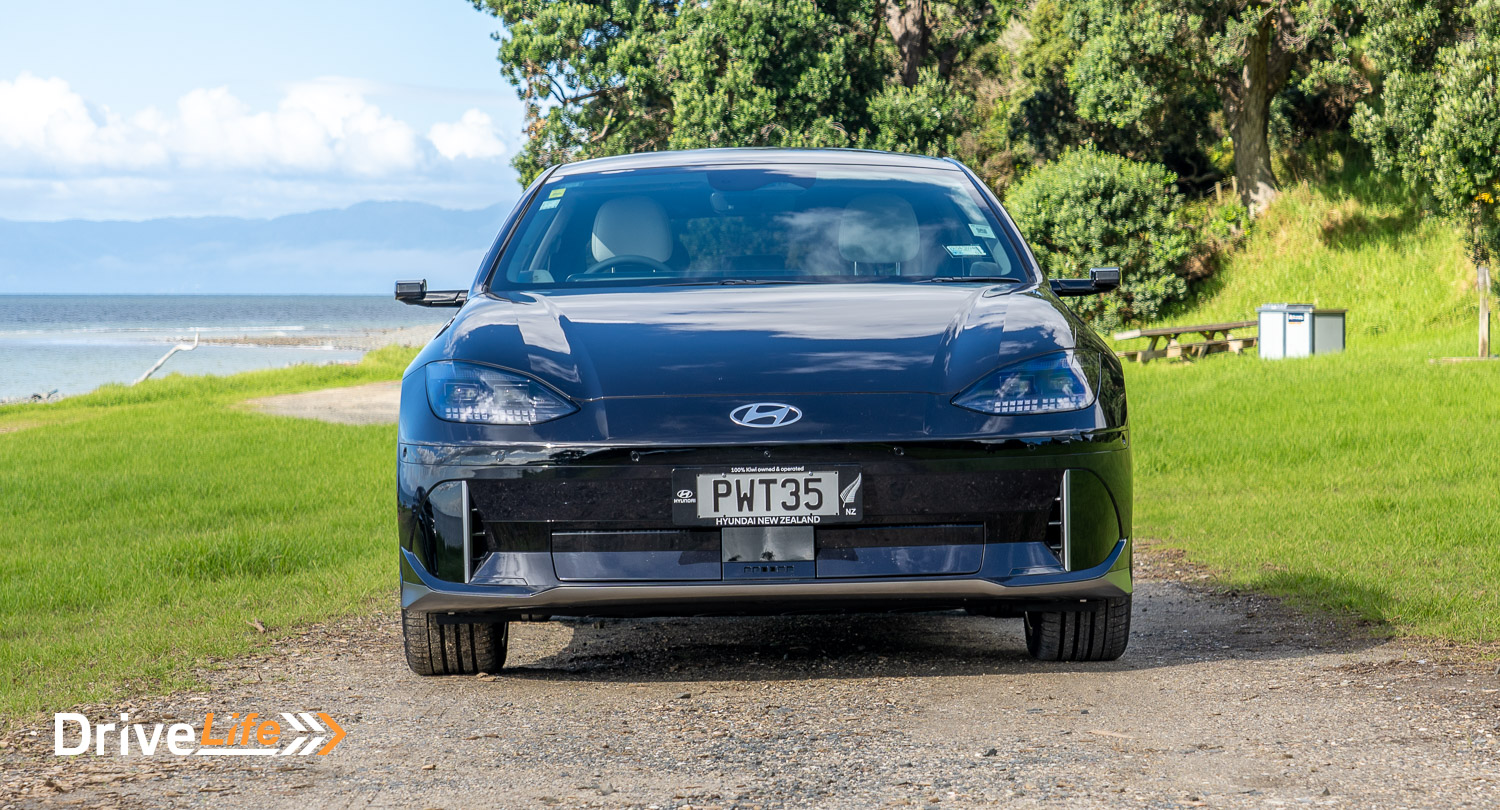
There are also air curtains that channel air around the wheels to reduce drag, a reduced wheel gap to redirect airflow around the nose of the car, a “single curve exterior shape” and flush door handles like the Ioniq 5.
That drag coefficient result of 0.21 is for the 77kWh battery model with rear-wheel drive.
Around the rear of the car, there are vertical rear reflectors and reversing lamps in the rear bumper, an integrated spoiler with high-stop brake lamps, and parametric taillights.
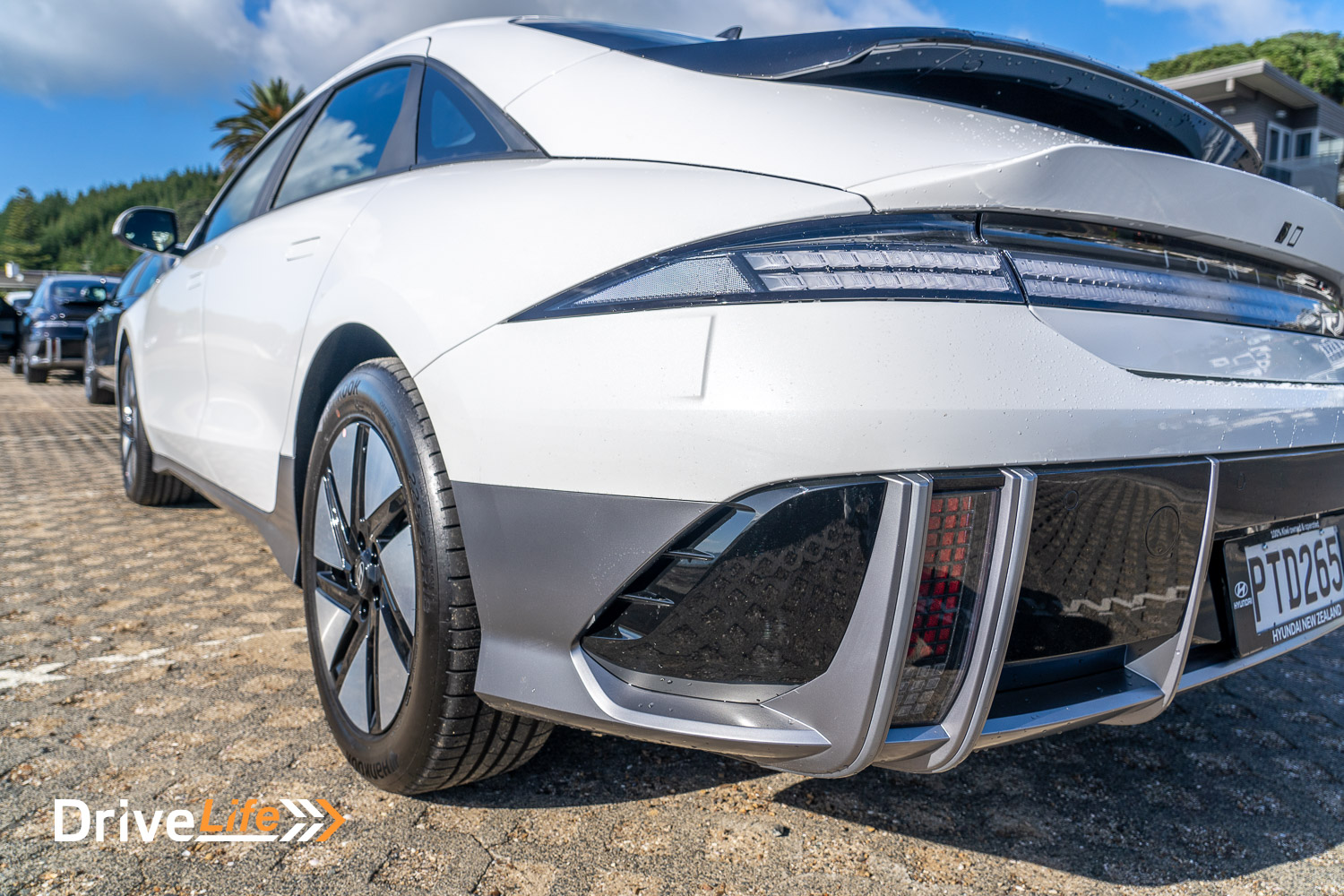
On the lower models, 18” alloys wheels are standard, with 20” alloys and 245/40/20 Pirelli P-Zero tyres on the top-spec Limited.
Cargo space is listed at 14.5 litres from the frunk on the all-wheel drive model, and 45 litres in the rear-wheel drive. Both models have 401 litres of space in the boot. There is no spare.
The car is rated to tow 750kg braked or unbraked for the 53kWh battery models, and 750 unbraked/1,500kg braked in the 77.4kWh battery models.
Digital side mirrors are fitted to the Limited version, reducing its overall drag.
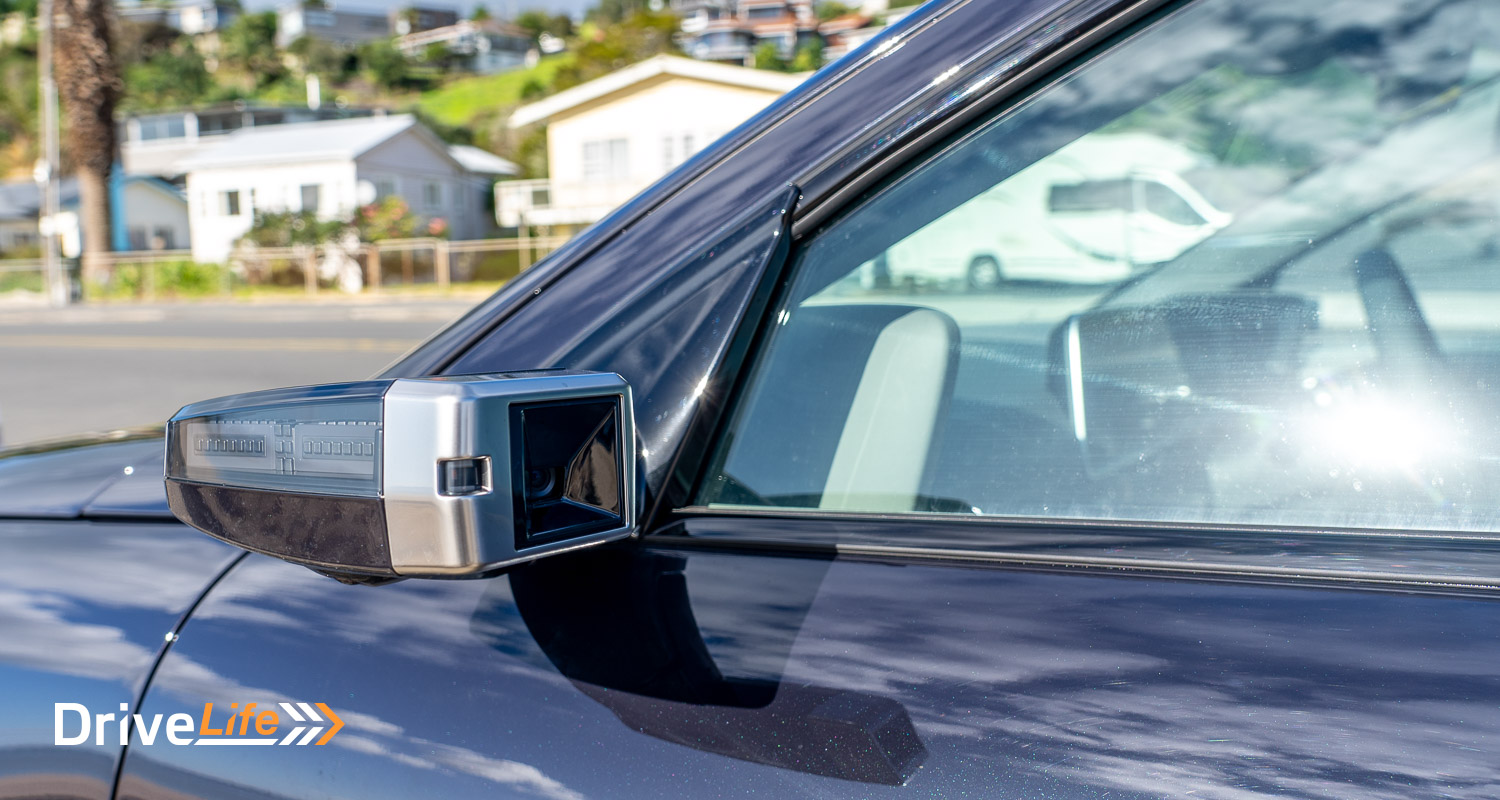
IONIQ 6 Launch: Interior
Space isn’t an issue inside the Ioniq 6, with front-seat legroom rated at 1.154m, and rear-seat legroom at 996mm. Headroom is excellent too, at 1,022mm in the front, and 937mm for rear-seat passengers.
An eye-catching feature is the two 12.3” display screens, with very high resolution. These really are a benchmark for other brands. The clarity is outstanding.
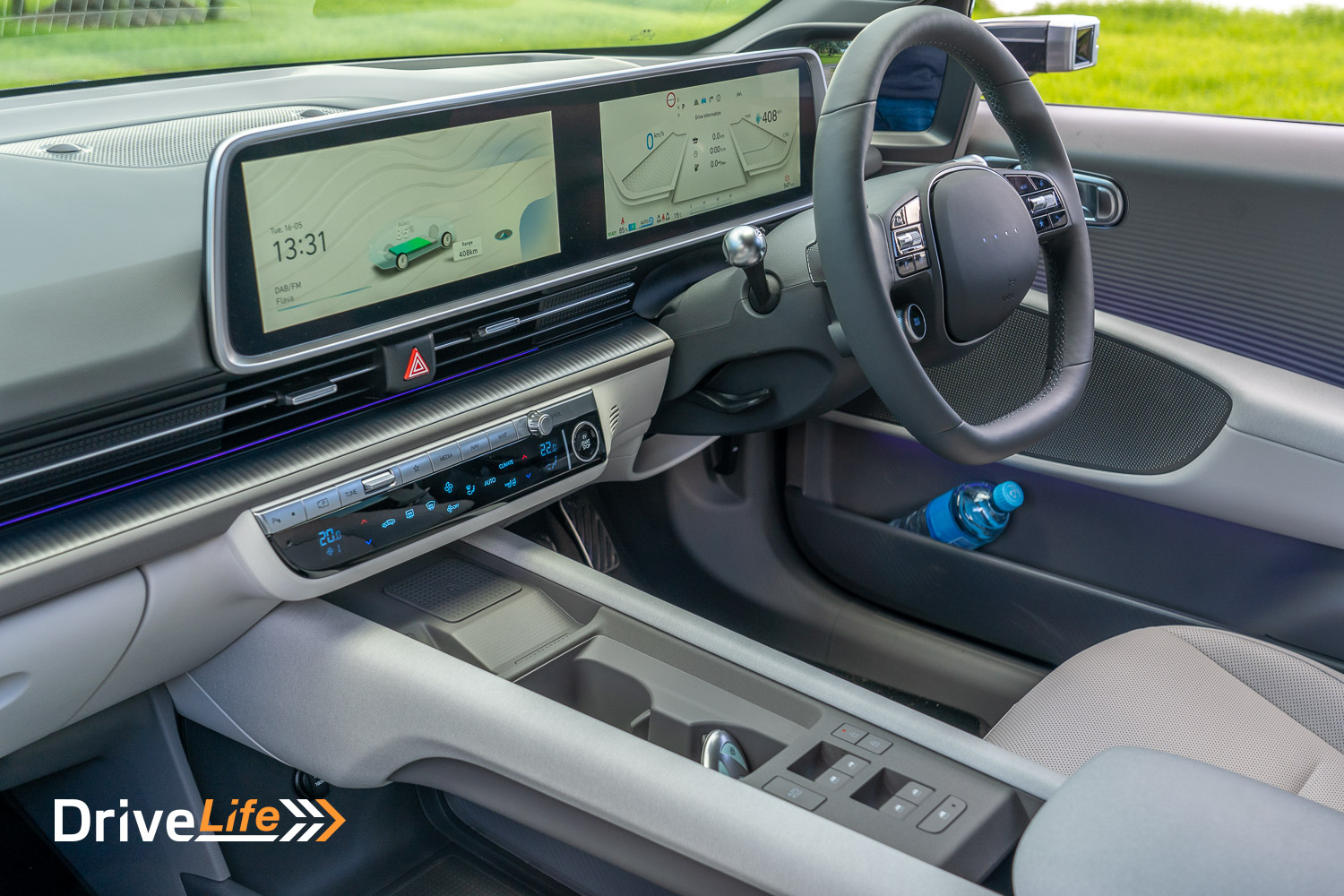
The Limited model is fitted with an interactive LED steering wheel. This means there are 4 LEDs fitted to the centre of the steering wheel, and perhaps by coincidence (but really, not) 4 dots in Morse Code stands for an ‘H’. Regardless, their LEDs change colours to give you information, like a change of drive mode, red LEDs when you are in reverse gear, and increasing LEDs when charging.
The Limited also has a heads-up display (HUD) to supply the driver with info around SatNav, speed, speed limits, audio etc.
The centre of the car is a departure from the Ioniq 5, with a fixed centre console, that Hyundai calls a “Bridge Centre Console”.
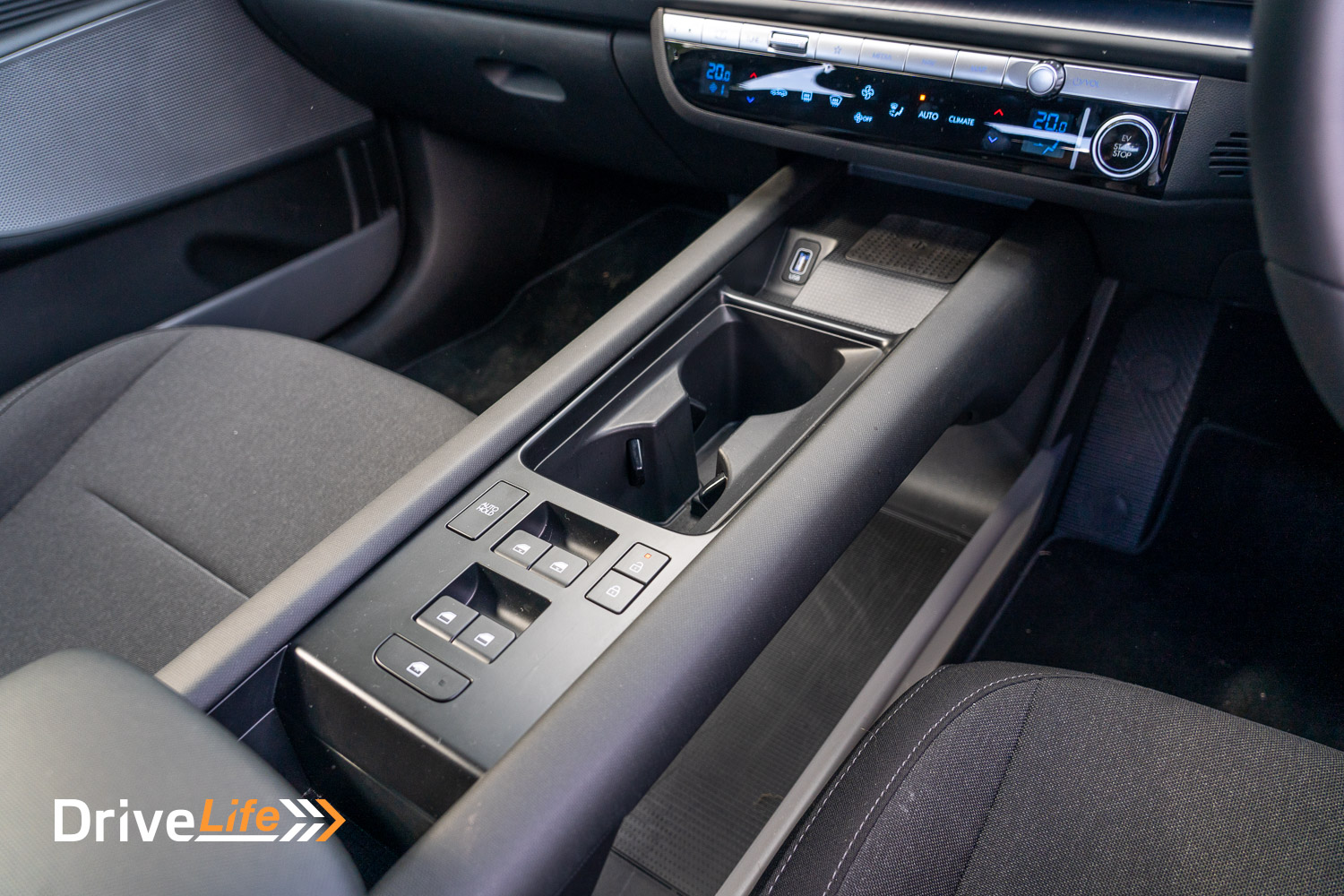
Other interior features of the Limited include the Relaxation Seats, that we saw in the Ioniq 5. These are essentially for when charging, to allow the front-seat passengers to relax and unwind while the kilowatts are fed into the car. The front seats are heated and cooled in the Limited model.
The Elite and Limited models have an 8-speaker Bose sound system, and Apple CarPlay and Android Auto is standard across the range. Weirdly for such a new, modern car, these are not wireless so you’ll need to use a USB cable to make this work. Also slightly weirdly, instead of having a USB-A port and a USB-C port, Hyundai has stuck with the old USB-A style.
On the sustainability front, for models that have a leather interior, this is eco-processed leather. Bio-paints are used on the door cards and dashboard, and recycled fishing nets are used in the carpets.
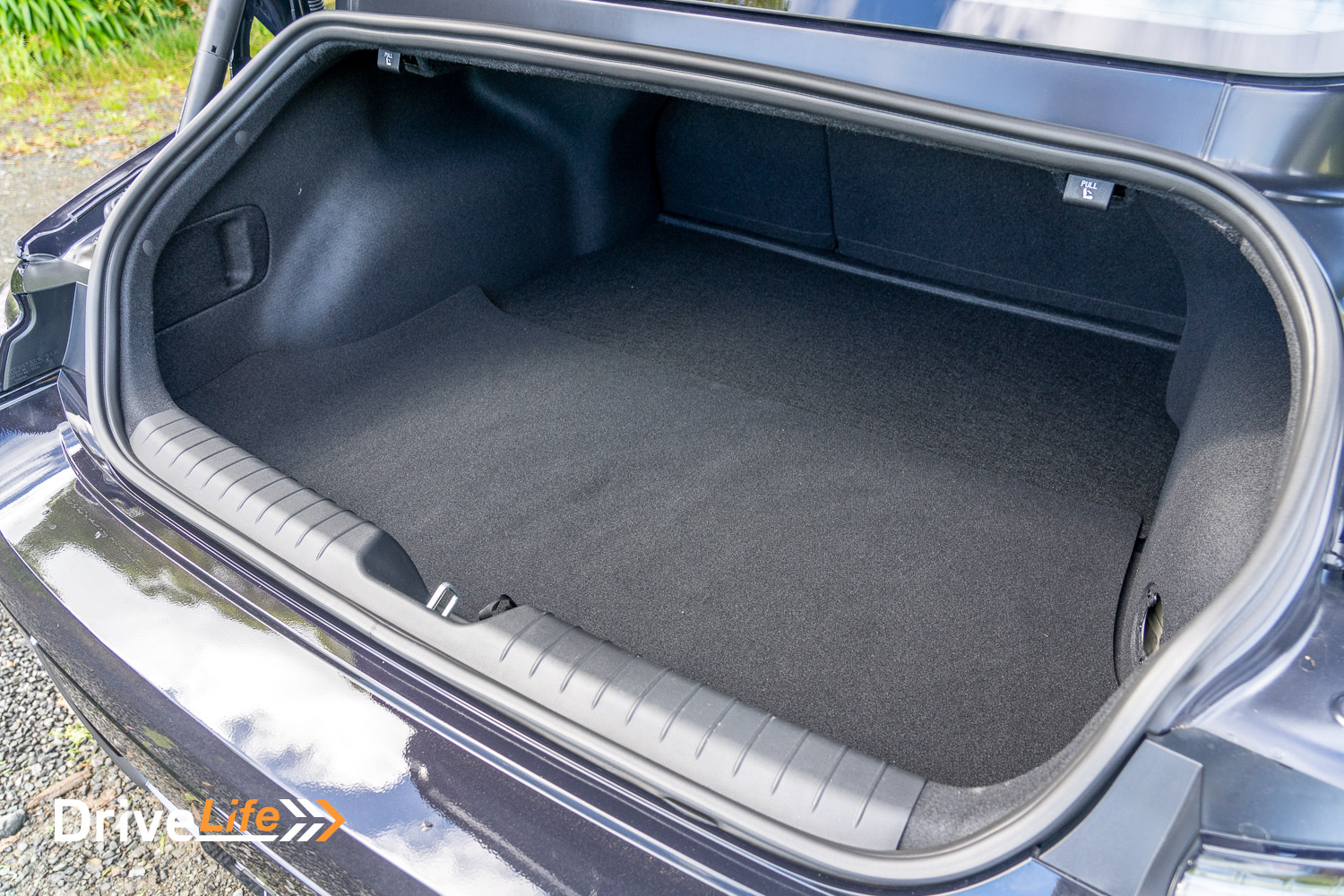
IONIQ 6 Launch: Other Specs & Info
The Ioniq 6 comes with both a Euro and ANCAP 5-star safety rating, a good achievement. The Elite and Limited models have adaptive matrix LED headlamps.
Elite and limited have intelligent LED headlamps, matrix LED headlights, and automatic partial high/low beam.
All models have Hyundai’s Smart Sense safety package, that includes:
- Forward Collision avoidance to Level 1.5 on the entry model and Elite and level 2 on the Limited. That Level 2 includes crossover and side protection.
- Intelligent speed limit assist
- Lane Follow Assist
- Lane Keep Assist
- Adaptive Cruise Control
- Blind Spot Monitoring
- BSM View Monitoring
The Limited version adds:
- Parking Collision Avoidance
- Rear Cross Traffic Alert avoidance assist
- Rear occupant alert
- Safe Exit warning
- Surround-view monitoring
- Rear Cross Traffic Alert Collision Warning
- Remote Park Assist Level 2; this means that using the keyfob, the driver can get out of the car and use the remote to auto-park it. This now includes diagonal (angle) parking.
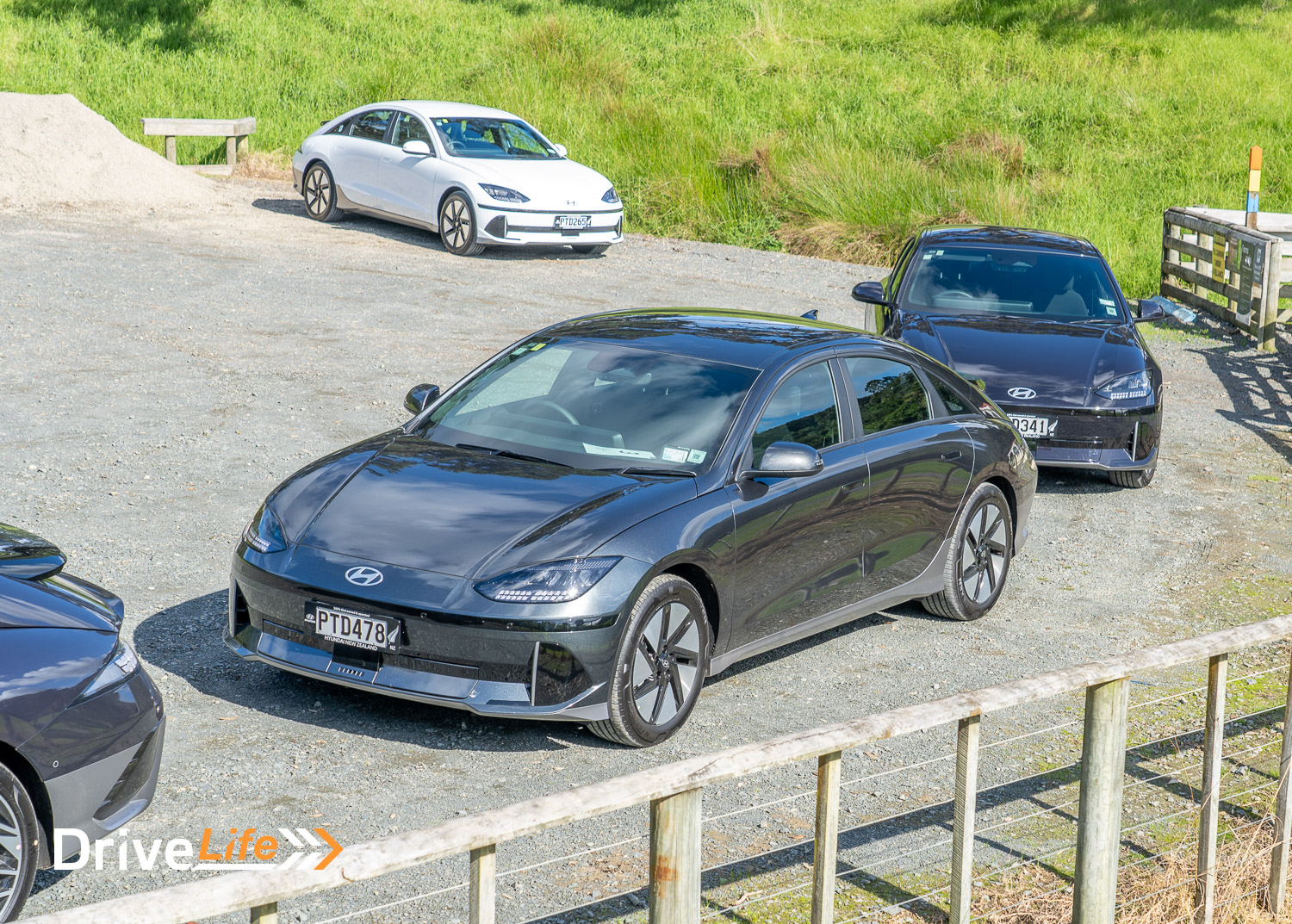
IONIQ 6 Launch: Models, Pricing, Power, Range
There are three models in New Zealand:
- Ioniq 6 (rear-wheel drive)
- Elite (rear-wheel drive)
- Limited (all-wheel drive)
You can get the base Ioniq 6 model with a big or small battery:
Ioniq 6 53kWh: $79,990 (111kW power/350Nm torque/range 429km)
Ioniq 6 77.4kWh: $94,990 (168kW power/350Nm torque/range 614km)
There is just one model of Elite, it comes with the bigger 77.4kWh battery and is priced at $104,990. It also has 168kW of engine power and 350Nm of torque. It has up to 545km of range.
The Limited is $124,990, has all-wheel drive and puts out 239kW of power and 605Nm of torque and has a range of 519km.
There are nine colour options for your Ioniq 6, six are muted but there is one red and one blue option.
On the inside, there are 3 interior options;
- Black woven cloth for the base models
- Dark grey two-tone eco-leather
- Black monotone eco-leather
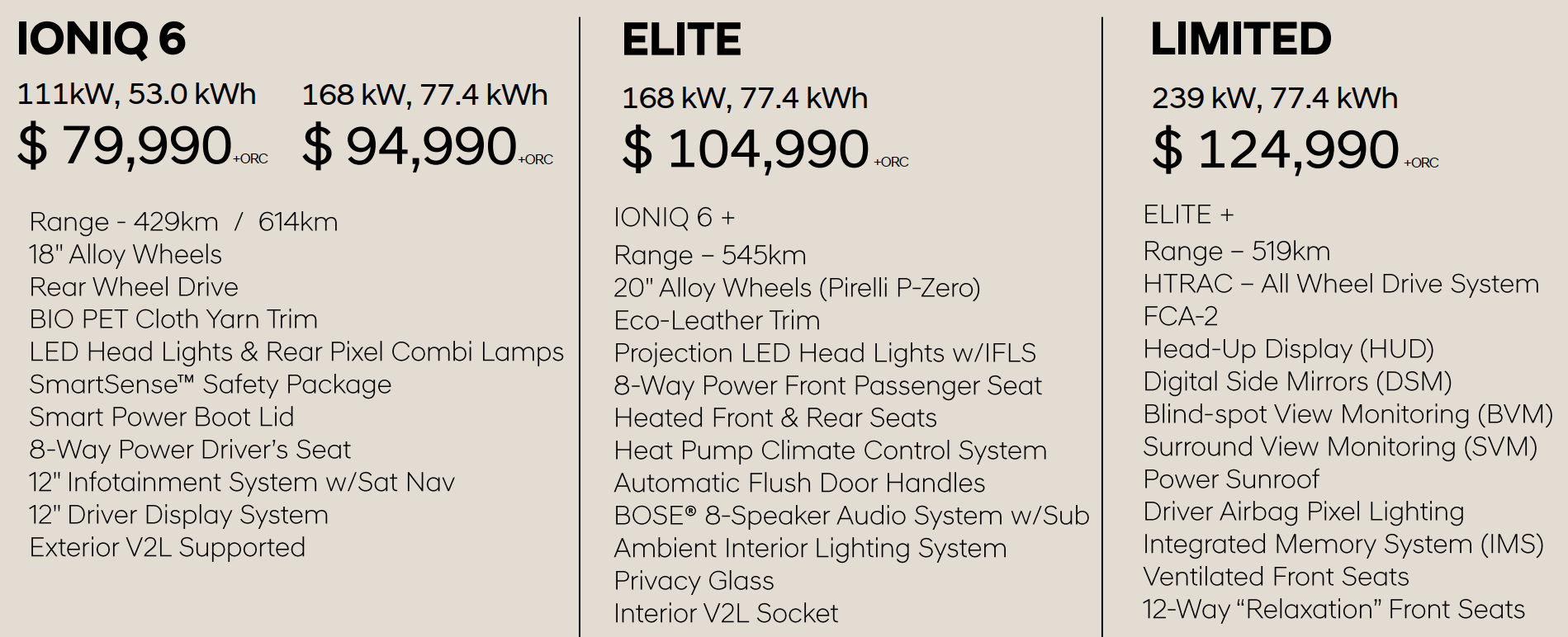
2023 HYUNDAI IONIQ 6 LAUNCH: DRIVE TIME
First up, we got into a base model, so rear-wheel drive with the smaller 53kWh battery. The car still feels luxurious, and equipment levels still seem good – as they should be at near-on $80K.
The dash is similar to the Ioniq 5, with the infotainment system identical. The centre console area is the biggest departure from the Ioniq 5, with the cool sliding centre console feature replaced with a fixed console. In saying that, there is loads of room to store stuff both above and below the console. It’s very usable in that respect.
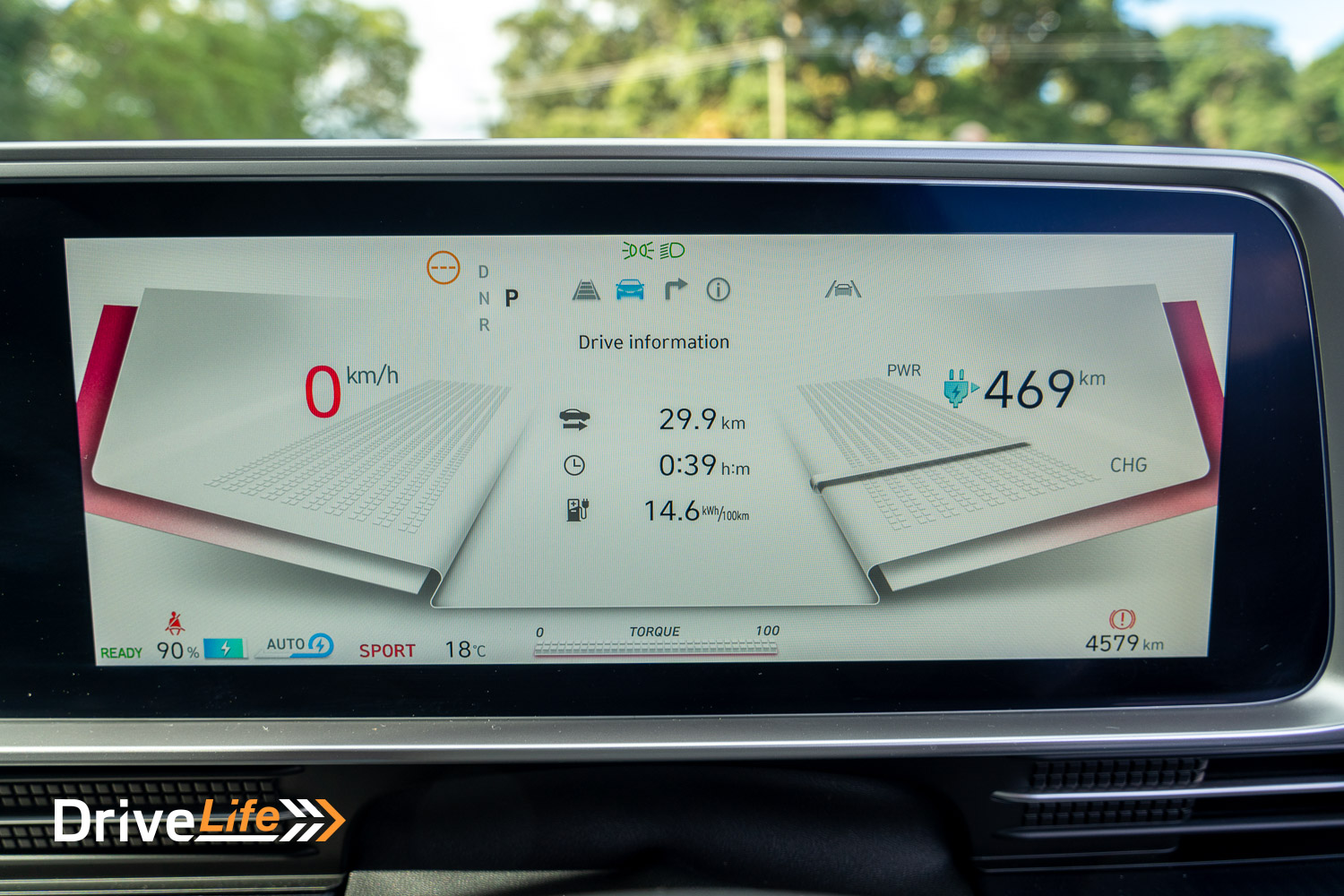
Since the gear selector is mounted on the steering column, there’s little clutter on the console except for the power window switches that have now moved here. It feels almost retro in that respect but the doors look a lot cleaner simply by not having a power window switch on them.
The base model Ioniq 6 only comes with a black-cloth interior, and although this can generally make a car feel smaller inside, there is an overall feeling of spaciousness coming from that EV-only platform. There is an abundance of leg, shoulder and headroom for all passengers.
Wind and road noise are very well subdued in the car, and even tyre noise isn’t too bad on coarse chip seal, where it would normally be bad. This might be helped by the Nexen tyres fitted to the base model, with their high (by current standards) 55 profile tyres. The car does feel quieter inside than the Ioniq 5, but not by much.
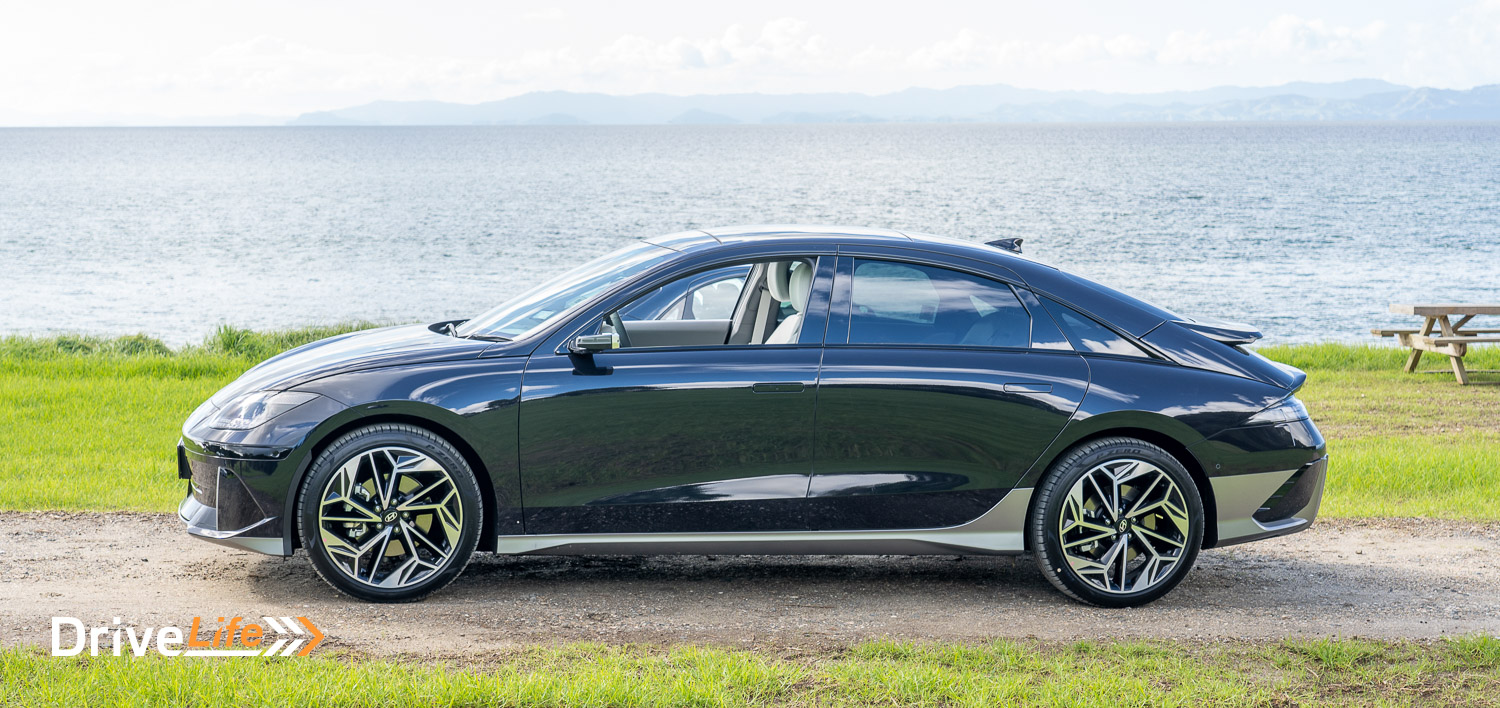
Driving the Ioniq 6 is a reminder of the Ioniq 5 – easy, simple, peppy, and it sits very well on the road. This feels like a car for a long trip. Performance is more than acceptable, even if there is ‘only’ 111kW of power available. The 350Nm of torque certainly helps the car along the road at a good pace.
We dropped the base model and moved up to another base model, but this time with the bigger 73kWh battery and 168kW of power now available from the electric motor. That’s the only difference between the two models, other than the $15K price difference. The performance increase is noticeable since there is an extra 57kW of power available.
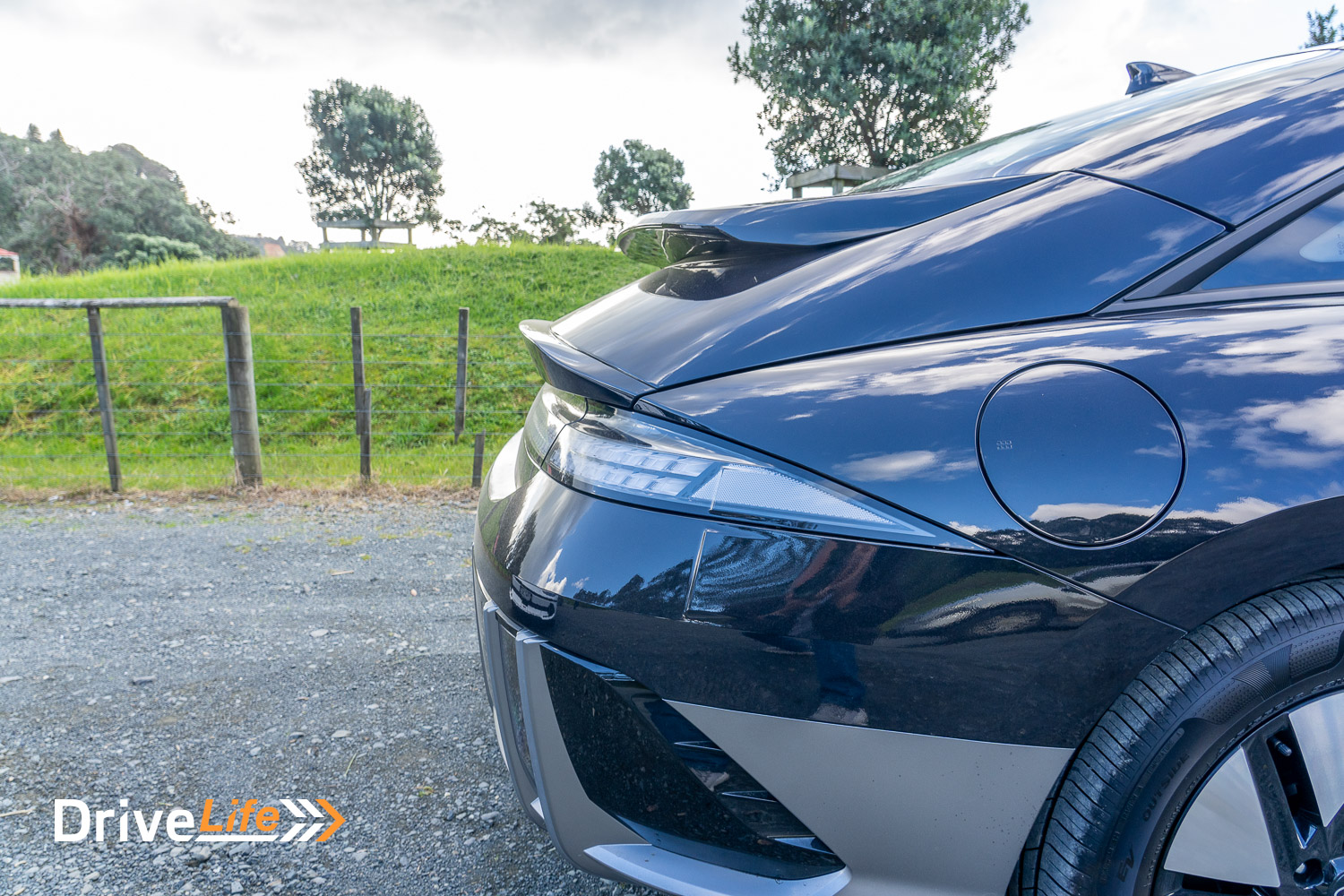
We wouldn’t be getting into an Elite model today, so instead went straight to a top-spec Limited. This means all-wheel drive, 239kW of power and a meaty 605Nm of torque – along with a range of around 519km. The Limited has the same, larger 77.4kWh battery pack.
With 20” wheels and Pirelli P-Zero tyres, there’s a little more tyre noise in this car, but we only notice it since we’ve driven them back-to-back. Like the other models, on the whole, wind, tyre and road noise are very well managed.
The grey interior of the Limited is a lot more inviting and the change of feeling of absolute space is marked. I’d be going all out to avoid the black interior if I could – this is the colour to go for.
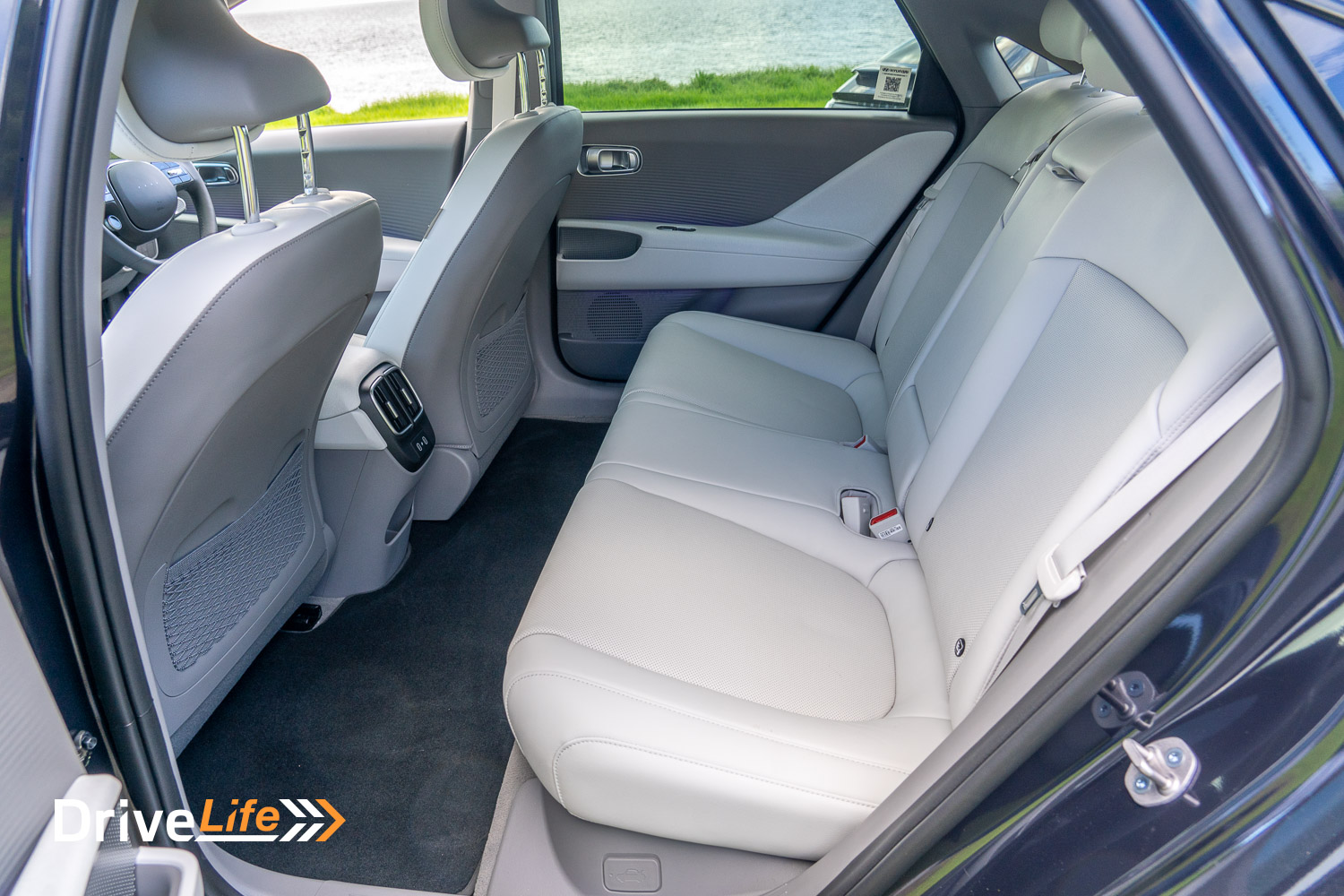
Behind the wheel, performance is very EV-like; instant and noiseless. Handling of this car is very good, and it sits on the road very well. The corners we were taking were a little demanding, but the Ioniq 6 Limited nailed them. Steering feel is reasonable, and overall it’s a great handling car. We’ll wait to give a final verdict on this when we get the car to review, however.
On checking the dash numbers, the car we were in had covered just over 600km and had returned 17.9kWh100km. This is only 1kWh/100km more than Hyundai suggests, so not a bad energy economy figure.
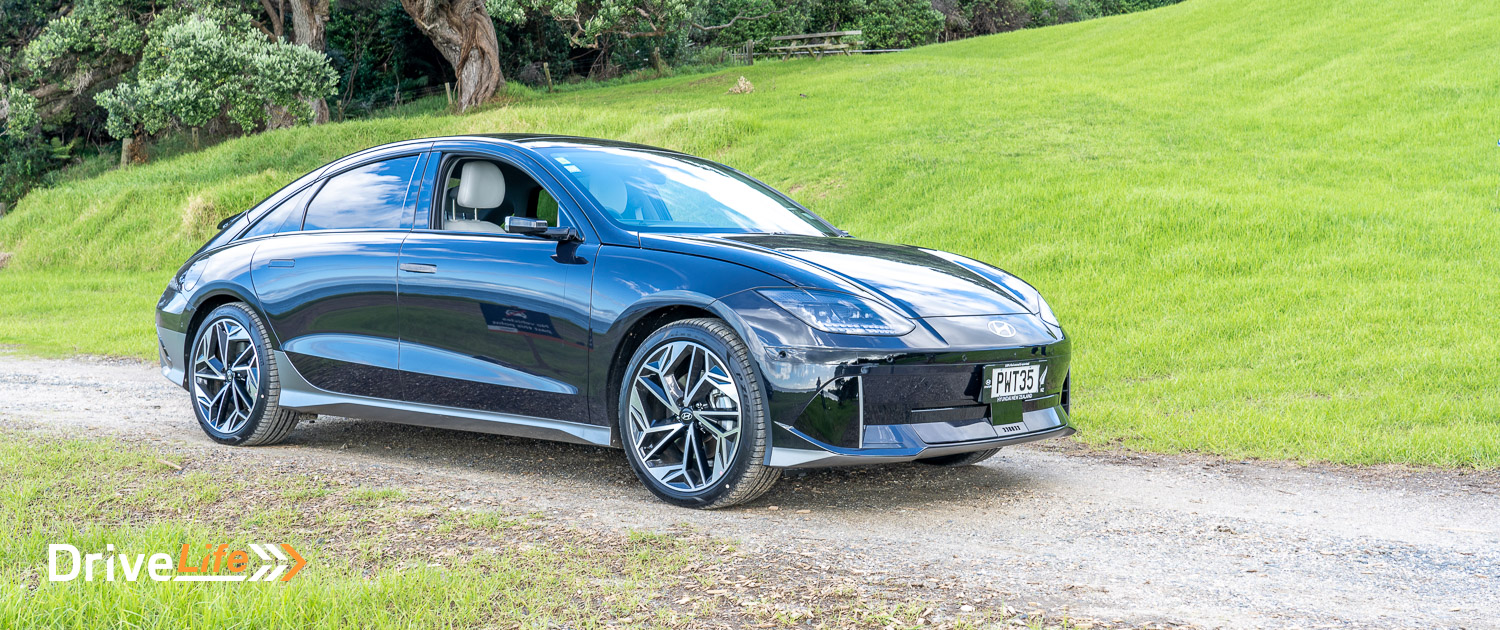
Digital mirrors are fitted to the Limited model, and it does not take long to get used to these. The two screens are closer to your line of sight, so the driver doesn’t need to look as far to see the screen, which is a nice safety bonus. The actual quality of the image is superb – it’s just like looking at a normal mirror.
On returning to Hyundai New Zealand’s headquarters, our first impressions of the Ioniq 6 are very good; that E-GMP platform is excellent, adorning the car with space, handling, and efficiency. We eagerly await one to review.
